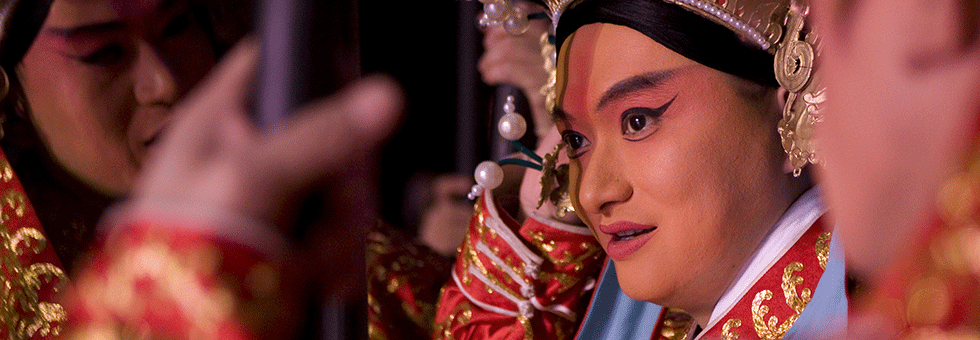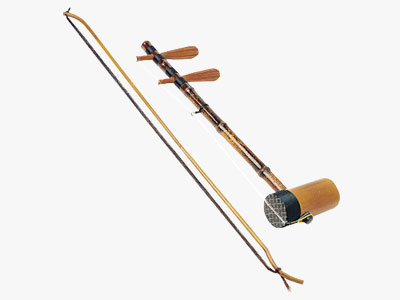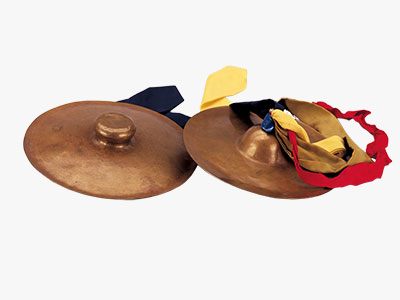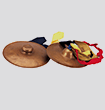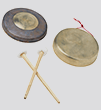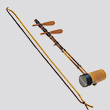Roles
The roles in Peking opera are differentiated into fixed character types: sheng (male role), dan (female role), jing (painted faces), and chou (male clowns). Different singing and acting techniques gave birth to various schools. Each type of character has its own set of performance conventions.
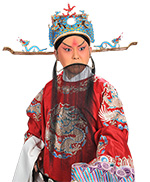 |
The sheng 生 is the main male role in Peking opera, which has numerous subtypes. For example, the laosheng is a dignified older role with a gentle and cultivated disposition. Young male characters as xiaosheng sing in a high, shrill voice with occasional breaks. The wusheng is a martial character for roles involving combat who is highly trained in acrobatics and has a natural voice when singing. |
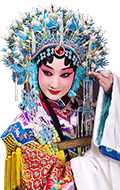 |
The dan 旦 refers to any female role in Peking opera. Dan roles were originally divided into five subtypes. Old women were played by laodan, martial women were wudan, young female warriors were daomadan, virtuous and elite women were qingyi, and vivacious and unmarried women were huadan. A troupe will have a young Dan to play main roles, as well as an older Dan for secondary parts. |
The jing 净 is a painted face male role. Depending on the repertoire of the particular troupe, he will play either primary or secondary roles. Jing will entail a forceful character that has a strong voice and is able to exaggerate gestures. There are 15 basic facial patterns, but over 1000 specific variations of those. Each design is unique to a specific character. |
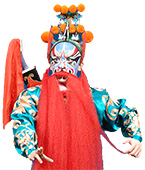 |
The chou 丑 is a male clown role. The chou usually plays secondary roles in a troupe. Indeed, most studies of Peking opera classify the chou as a minor role. Chou roles can be divided into wenchou, civilian roles such as merchants and jailers, and wuchou, minor military roles. Chou characters are generally amusing and likable, if a bit foolish. Their costumes range from simple for characters of lower status to elaborate for high status characters. |
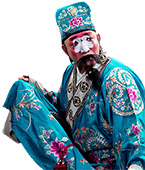 |
Makeup & Costume
The richness of colors and patterns of the makeup and costumes is probably one of the most astonishing features of Peking Opera. Each role has its meaningful makeup and each costume gives fundamental information about the nature of the characters.

The makeup of dan and sheng roles is sometimes regarded as 'beautifying makeup' (junban) and is relatively simple: first a layer of oil-based white make-up is applied; then peach-red rouge is applied by hand starting with the eyebrows and followed by the eyes and cheeks; after that, water-based black ink is used to draw thick black lines around the eyes and eyebrows; finally, the lips are highlighted with color. The entire process lasts less than one hour.
Jing and chou roles' makeup, called 'mask-like facial makeup' (lianpu) is far more complex. What makes especially jing characters such a fascinating part of Peking Opera is the fact that the pattern painted upon their faces can reveal their personalities. Whether brave, loyal or treacherous, an experienced viewer of Peking Opera only needs one glance on the face of a jing to know his true nature.
Jing faces can be distinguished according to their colors: red indicates uprightness and loyalty; black qualifies a rough and forthright character; blue signifies bravery and pride; white marks treachery. Jing faces can be also distinguished according to their facial patterns, including the way eyes, eyebrows, forehead, nose and mouth are drawn. Up to twenty-six types of eyebrows, for example, can be recognized: 'sawtoothed eyebrows', 'duck's egg eyebrows', 'butterfly eyebrows', 'willow-leaf eyebrows', 'bat eyebrows', 'sword eyebrows' and many others.
A typical make-up kit contains brushes, water-based paints, powder and oil-based paints. The facial patterns of a jing character are most often painted with a brush, but they can be applied by hand as well. The face-painter must take into account the individual shape and features of the face upon he is working. Except for famous and respected performers, which have a makeup assistant, the actor who impersonates the jing usually paints his face by himself.

The major costumes can be divided into four main groups: mang, a court robe worn only by imperial family members, prime ministers, or generals; pei, worn as casual clothing by imperial members or upper-class persons; kao, a kind of armor, worn by warriors; zhezi, worn as casual clothes by middle class and ordinary persons. Everything else goes under the umbrella term yi, 'clothes'. Each group actually includes countless sub-categorization and variations, different from one another in terms of colors and patterns. Beside the robes, costumes consist of elaborated and colorful shoes and accessories, such as crowns, helmets, hats, caps, hairstyles, belts and many others. Many costumes are specific for only one character.
Cao Cao, the treacherous warlord of the Three Kingdom period (AD 220-280) wears a mang.
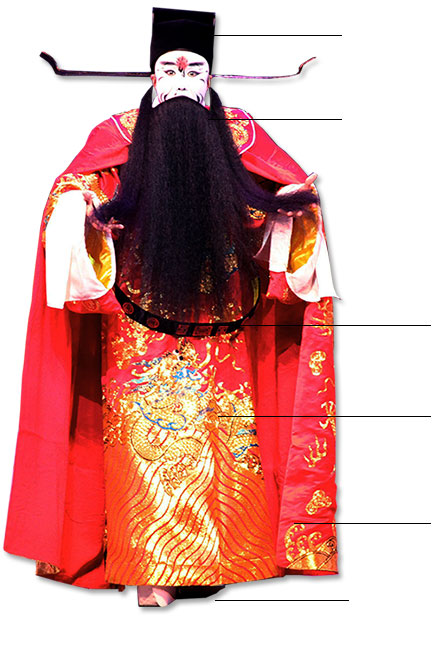
The plain black muslin hat, squared-shaped and with two wings, indicates an influential ruler.
The thick black beard made of yak feather is typical for jing roles, who are often military leaders. The black color suggests that the character is middle-aged. A grey or white beard would belong to an older jing.
Jade belts are used to indicate the status of nobles and high officials, both for female and male characters.
The red color indicates nobility. The mang decorated with "water-spitting dragon" patterns indicates Cao Cao's thirst for conquest. Traditionally, only the emperor would be allowed to have his robe decorated with dragons.
An open overcoat with dragon patterns is worn by military leaders.
The thick-soled boots are a common kind of footwear for both jing and sheng. The ticker is the sole, the higher is the character's status.
Sun Shangxiang, the deft and deadly woman warrior, sister of Emperor Da of Wu Kingdom (AD 182-252), wears a kao.
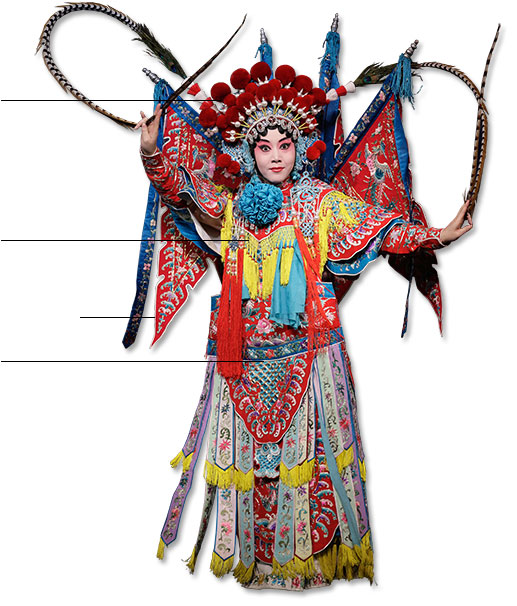
The fine "seven-stars" diadem consists of three rows of seven pom-poms each. A pair of long feathers is set on the diadem. During the battle, the feathers shake and wave, giving the character an aura of majesty.
The decorative cape, in Chinese named literally "cloud shawl" is worn around the neck and supported by the shoulders. In the Qing Dynasty (1644-1911), this dress was worn by women of all strata, especially during holidays or weddings.
Flags
The "firm" armor, usually adorned with flags, indicates that the character is fully armed and ready for the battle. It can be worn by both male and female characters. Another less elaborated type of armor is often worn by warriors during ceremonies and social occasions.
Xiao Qiao, the devoted wife of general Zhou Yu (AD 175-210), loyal to the rulers of Wu Kingdom, wears a pei.
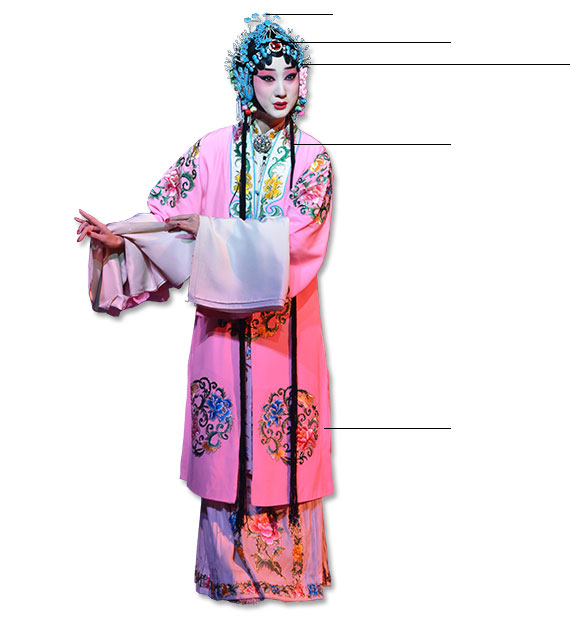
Crown jewel
Jeweled ornaments
Blue filigree ornaments pins
The datou is the most common qingyi hairstyle with bun. The hairstyle requires many steps to be completed. Firstly, cloth strips are used to stretch the skin of the forehead. Then hairs are attached: some curls at the top of the forehead, and other tufts on the sides of the head and along the cheeks. Hair pins are then inserted. A wig and padding are slipped on and tied into a bun in the back of the head. Finally, additional hair ornaments, jewelry and flowers are fixed.
The pink color and the peony patterns are typical for young dan characters.
Xu Xian, the humble scholar who falls in love with the legendary White Snake, wears a zhezi.
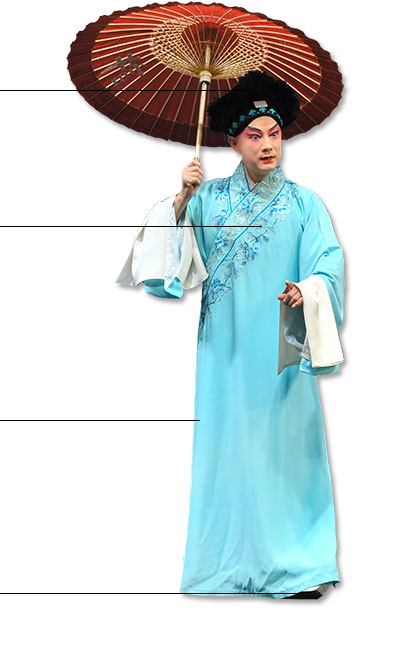
"Duck-tail" cloth hat: hat worn by common people in ancient China. High and narrow in shape, it bends slightly forwards; it has tassels on top representing a duck tail.
Collar with two patterned stripes.
Light-blue zhezi: the lilac gown is often worn by scholars who are from poor families or who have failed many times in imperial examinations.
"Good fortune shoes" with embroidered character shou (long life). Usually worn by elderly commoners (laodan or laosheng), also by the wenxiaosheng.
Skills and Training
Peking Opera and the Western Opera differ from one another in many ways. One of the main differences lies in the skills a performer needs to master, and consequently, in his training. The Peking Opera performer should be well-versed in singing, recitation, acting and acrobatics.

Singing. The vocal music system in the West is divided into tenor, baritone, bass, soprano, mezzo-soprano and alto. It is up to the composer which vocal range he chooses for example for the role of a young man. The vocal music system in Peking Opera is entirely different. Each role has its own particular singing style, and inside each role category, many other different singing patterns can be distinguished. For example with respect to the dan roles, the role of laodan (elderly woman) mainly uses the real voice, whereas the role of qingyi (young woman) uses mainly falsetto. A performer can play any role as long as he or she masters the singing style of that particular role. An actress can play the role of a painted face - a male character, whereas a male actor can play a dan (female) role.
Recitation. Recitation tells the story, whereas singing is more concerned with expression of emotions. The performer speaks in changbai, a speaking technique different from the daily speaking, in which honorific terms abound. The actor rises or muffles his voice and lengthens certain syllables to create a specific rhythm. The goal is never to imitate a conversation in a realistic way.
Acting. The Peking Opera actor possesses fine mimic skills. Without the support of complementary stage design, he has to describe the situation and the environment around him through his gestures. When the actor makes his appearance on the stage followed by a servant holding a light, the audience immediately understands that the scene takes place during the night; he opens and closes a door where there is no door at all on the stage; he mounts or dismounts a horse, boards a ship or leaves it.
Acrobatics. Acrobatics has been for long Peking Opera's most appreciated feature by Westerners. Performers' acrobatic skills are mostly displayed in the form of martial arts. Combats are often the highlight of martial plays; the audience's interest is hold by a crowded punch-up or the reckoning between two bitter enemies.
Since a good Peking Opera performer has to master so many different skills, the apprenticeship can be very rough and challenging. Chen Kaige's famous movie Farewell My Concubine, remarkably described how the hard training for Peking Opera performers looked like at the turn of the 19th century. Pupils were sent away from home to schools, where their teacher trained them during a period of seven years. After the Japanese invasion of China in 1931, the schools were closed down. New schools with a completely different approach to the art reopened in the fifties.
Today as in the past century, performers are first trained in acrobatics, followed by singing and acting. Modern schools teach the art of performance as well as some theory. The education of a Peking Opera performer still consists in face-to-face tutoring; the teacher valuates the students and, assigns them the roles of primary, secondary, or tertiary characters according to their talent. Promising students perform as main characters, while students endowed with less performing talent may serve as musicians.







